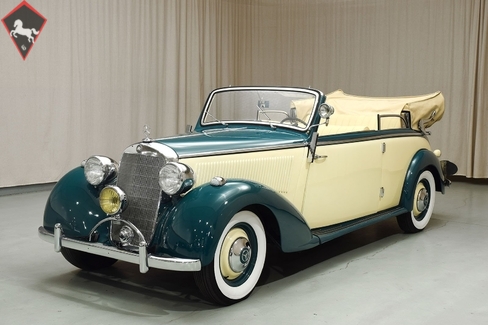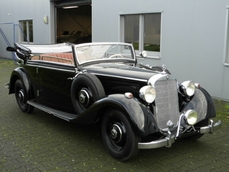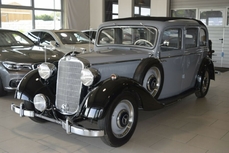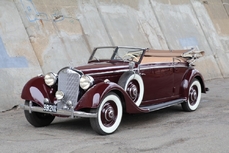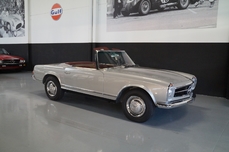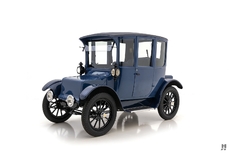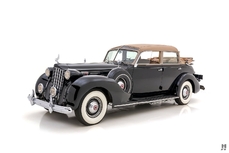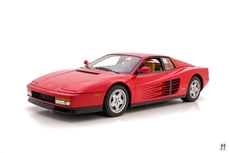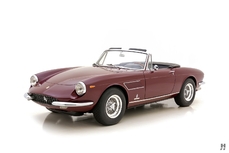Mercedes-Benz 230 W143 / W153 1940
Allmän beskrivning :
For the casual enthusiast, Mercedes-Benz models of the immediate pre-war period can seem rather confusing, with many of the same model designations being utilized on different chassis and bodies. The Mercedes-Benz W153 was a mid-range luxury car that, typically for Mercedes at the time, was offered in a variety of factory body configurations, and one of several vehicles known simply as the “230”. It was sold in conjunction with the older W143 beginning in 1938, with production ceasing in 1941, though it was reborn after the war as the 170S. Body styles included a sedan, two-seat Cabriolet A, four-seat/two-door Cabriolet B and four-door/four-seat Cabriolet D.
When compared to the W143, the W153 had more full-bodied and modern styling complete with an integrated trunk. The chassis of the W153 was derived from the earlier car, an oval-tube affair with independent front and rear suspension and four-wheel hydraulic drum brakes. The six-cylinder engine displaced 2.3 liters (hence the “230” moniker) and breathed through a pair of Solex carburetors, making just 55 horsepower; thanks in part to the low 6.6:1 compression ratio. Power output was about the same as the W143, albeit with a bit more refinement and torque while power was fed to the rear wheels via a four-speed fully synchronized transmission. Performance is understandably relaxed, but the refinement and quality make the car feel much younger than its pre-war roots suggest. Germany’s government policies effected production as Mercedes was left little choice but to support the war effort, and as such, just 4,264 cars were produced through 1943.
This W153 230B Cabriolet B hails from 1940, and is a very attractive example of this rare and desirable pre-war Mercedes-Benz. Originally delivered to a Swiss customer, its history has been well documented through to present day. It has been treated to a comprehensive, photo-documented body-off restoration which was completed in 2009. It presents very handsomely with its aqua-green fenders and hood, with cream body sides and interior. The color-keyed green and cream wheels add a nice touch, and the exterior is very well detailed with period accessories such as a cowl lamp, semaphores, and a wonderful, large amber fog lamp mounted in the center of the grille on a unique arched bracket. The paint presents beautifully, with flawless reflections and good panel fit on the body. The chrome is likewise in beautiful order, with a gorgeous grille and fully chromed headlight pods forming the centerpiece of the front end. The lamps all wear correct fluted Bosch lenses, including the large and rare fog light. A Swiss identification plate is mounted to the chrome rear bumper, reminding us of this car’s origins.
In its day, the 230 was a car for the financially comfortable client. This fact is reflected in the luxurious interior, which features extensive wood trim and leather upholstery. The two-tone paint theme carries over into the cabin, with the green dash and cream-beige leather mirroring the colors of the bodywork. The upholstery is beautiful and shows very little in the way of use since the restoration was completed. Proper German square weave carpet lines the floor and the large rear seat features a fold down center arm rest. The signature of the Cabriolet B is the large folding top, which allows for plenty of room for four passengers whether in the up or down position. This example is properly upholstered in Sonnendeck canvas, and a large boot finishes off the looks when folded.
Motivation comes via the 2.3 liter inline six which looks good and runs strong. The engine bay is tidy and pleasingly detailed. This example features a floor-shift four-speed manual, and the full-synchromesh makes it a breeze to drive in all conditions. A particular highlight of our 230 Cab B is the full set of original fitted luggage found in the boot. Along with the fabulously well-preserved luggage, the requisite spare wheel shares space with a period jerry can and tool set. It is a wonderful collection of period accessories that only serve to enhance the charm of this handsome touring car.
With known history dating back to 1940, a full complement of wonderful period accessories and a very high quality restoration, this 230 Cabriolet B is a very desirable and rare Pre-War Mercedes Benz that would be very well suited to show or touring. It is our pleasure to offer it for sale.
http://hymanltd.com/vehicles/5704-1940-mercedes-benz-230-cabriolet-b/
1940 Mercedes-Benz 230 W143 / W153 is listed såld on ClassicDigest in St. Louis by Mark Hyman for $199500.
Fakta i bilen
Karosstyp : Personbil Märke : Mercedes-Benz Modell : 230 W143 / W153 Motorvolym : 0.0 Årsmodell : 1940 Karosstyp : Convertible Läge : Missouri
Såld
Information om säljaren
Såld
People who viewed this Mercedes-Benz 230 W143 / W153 also viewed similar Mercedes-Benz listed at ClassicDigest
Other cars listed for sale by this dealer
om Mercedes-Benz
I automobilhistoriens krönika utvecklas Mercedes-Benzs resa som en berättelse fylld av uppfinningsrikedom från sina grundande pionjärer. År 1886 skapade Karl Benz Benz Patent Motorwagen, en skapelse som skulle gå till historien som världens första bil. Okunnig om detta markerade stunden början på det som skulle utvecklas till den mest ansedda premium-biltillverkaren globalt. Den ekonomiska grundvalen för detta banbrytande företag tillhandahölls intressant nog av Karl Benz fru, Bertha Benz, vilket visade på ett anmärkningsvärt partnerskap som skulle sätta tonen för Mercedes-Benzs arv.Inte långt därifrån framträdde en parallell berättelse när Daimler-Motoren-Gesellschaft, grundat av Gottlieb Daimler och Wilhelm Maybach, kom in på scenen. År 1901 avslöjade de sin bil under det nu berömda namnet "Mercedes", vilket betyder "guds gåva" på spanska. Detta namn tilldelades bilen på begäran av Emil Jellineks dotter, distributören för Daimler-Motoren-Gesellschaft. Innovationshjulen sattes i rörelse.
Hoppa fram till 1926, ett avgörande år som bevittnade sammanslagningen av Daimler med Benz & Cie., vilket resulterade i födelsen av Daimler-Benz. Sammanslagningen innebar antagandet av "Mercedes-Benz" som det framstående varumärket för deras bilar och förenade arvet från två visionära enheter till en.
I motsats till uppfattningen om konservatism vecklar sig Daimler-Benzs bana ut som en krönika av branschens första. Från introduktionen av honungskaksradiatorn till flytkarburatorn och den banbrytande implementeringen av fyrhjulsbromsar 1924 pressade Daimler-Benz konsekvent gränserna för bilinnovation. Den dieselkraftade Mercedes-Benz 260 D från 1936 markerade starten för dieselmotorer i personbilar. Den ikoniska Mercedes-Benz 300SL Gullwing gjorde historia som den första bilen med direkt bränsleinsprutning, även om Gutbrods lilla 2-taktsmotor kan göra anspråk på företräde.
Säkerhetsinnovationer blev en kännetecken, med Béla Barényis patenterade säkerhetscell i "Ponton"-modellerna 1951 med främre och bakre deformationszoner. W116 450SEL 6.9 såg införandet av Anti-Lock Brake System (ABS), ytterligare en banbrytande säkerhetsfunktion. Från de första serietillverkade krockkuddarna och därefter fortsatte "första" att etsas in i Daimler-Benzs tyg.
Under sin över hundra år långa resa har Mercedes-Benz inte bara producerat bilar utan har skulpterat ikoner. SSKL, 710 SSK Trossi Roadster, 770K Grosser, 540K Spezial Roadster, 300SL Gullwing, w100 600 Pullman, w111 280SE 3.5 Flachkühler, w113 230SL Pagoda, w109 300 SEL 6.3 och w201 2.3-16 Cosworth vittnar om märkets engagemang för ingenjörsexcellens.
De dånande Silver Arrows, eller "Silberpfeile", inklusive W 25, W 125, W154, W165 och W196, skapade ett arv av dominans på racerbanan. Dessa maskiner var inte bara bilar; de var uttryck för precision, hastighet och en oövervinnelig anda som lämnade sina konkurrenter i dammet.
När Mercedes-Benz går in i framtiden gör det inte bara som en biltillverkare utan som en förvaltare av ett arv, en fackelbärare av innovation och en fyr av bilaexcellens. Vägen framåt kommer säkerligen att bevittna den fortsatta föreningen av toppmodern teknik, tidlös design och ett obevekligt åtagande att sätta nya standarder inom bilvärlden.
